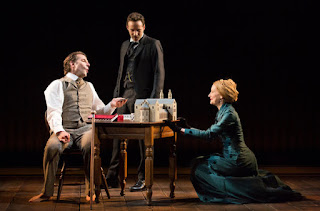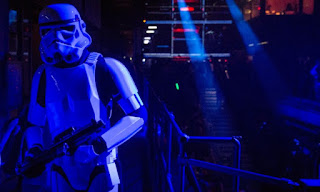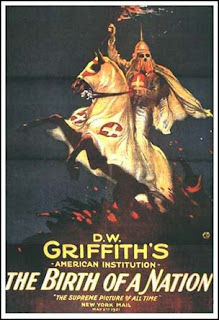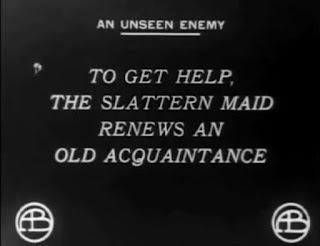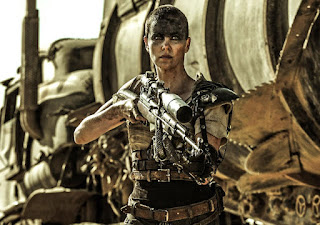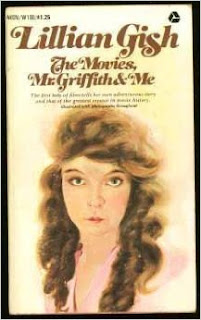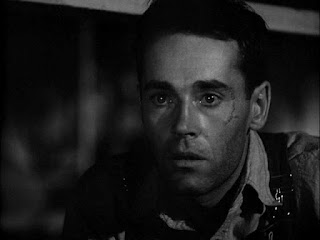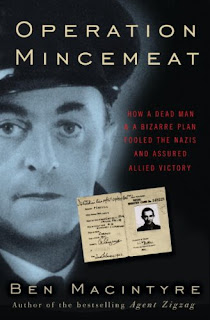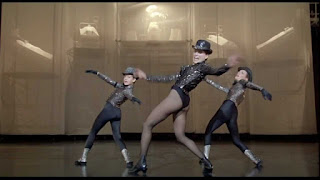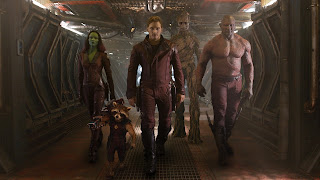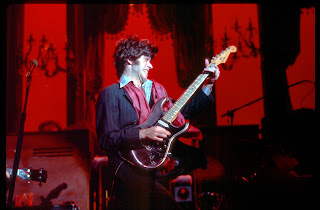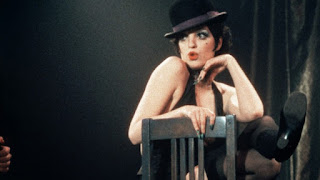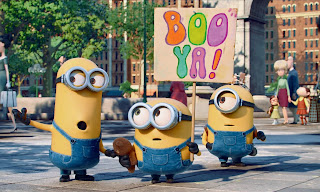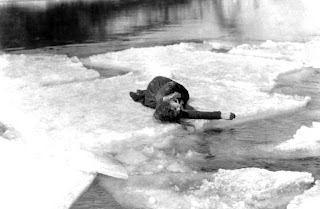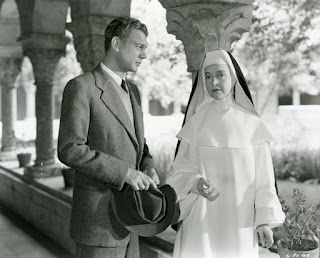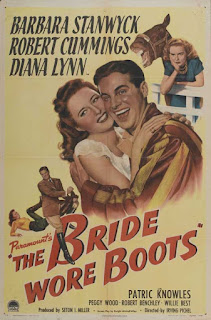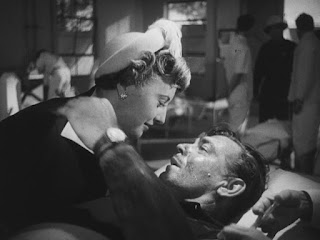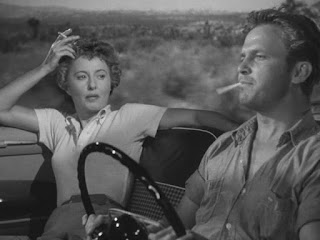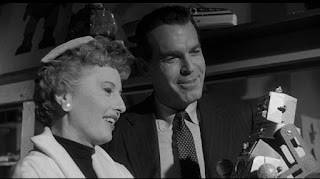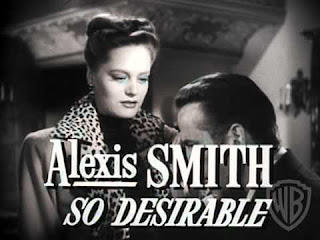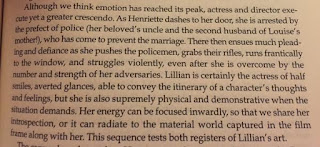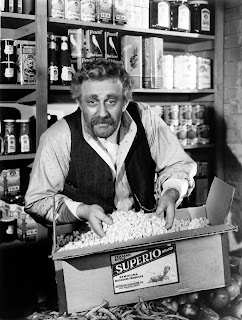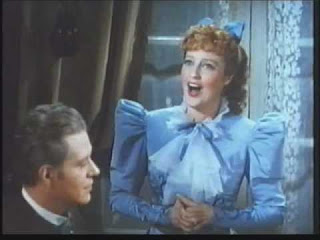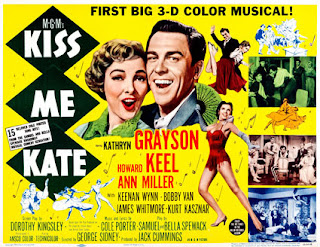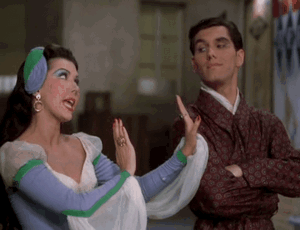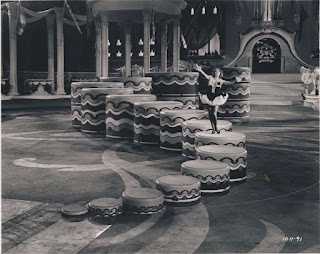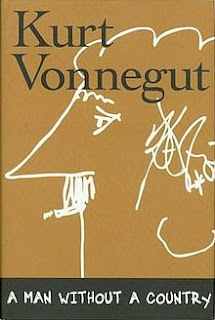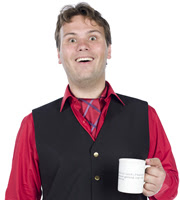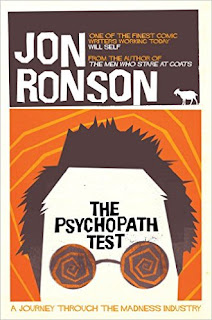Assorted bits and pieces from the careers of two of my favourite actresses,
Lillian Gish and
Barbara Stanwyck. You can click on those links for a bit of background.
GISH:![]() *MINOR SPOILERS*
*MINOR SPOILERS*
Broken Blossoms (D. W. Griffith, 1919) - This slow, bleak D. W. Griffith melodrama has achieved classic status, but I find it so completely over the top, in both its material and Donald Crisp's ludicrous villainy, that it's hard to get into.
Richard Barthelmess is a Chinese pacifist who travels to London to share the Buddha's teachings, but winds up a lonely opium addict instead. When he falls in love with a 15-year-old girl (Lillian Gish) who's terrorised by her father (Crisp) - a malevolent, embittered boxer living in squalor on the waterfront - you get the idea that it probably won't end well.
Crisp is farcical - constantly facing the camera and frequently mugging - and it all feels very aloof and detached compared to Griffith's usual work. Having said that, Barthelmess does a good job of inhabiting his part - if tending to display very little emotion or rather too much, and walking with a stoop that I hope he doesn't think is characteristically Chinese - while Gish is absolutely excellent, playing young yet world weary, abused yet enduringly innocent in some essential way, and masterfully articulating everything from the flowering of self-worth to a cacophony of head-spinning terror. The 'finger smile' she does here - improvised on the set - quickly became iconic, and it's a flash of genius.
Broken Blossoms is also quite a progressive movie for its time, especially considering it was made by Griffith, is subtitled 'The Yellow Man and the Girl', and stars a white man as a Chinese guy.
(2.5)![]() *MINOR SPOILERS*
*MINOR SPOILERS*
Way Down East (D. W. Griffith, 1920) - When I was a newspaper reporter, there was a local woman in her 90s who used to sometimes ring me up on newsdesk on a Friday (I think she was lonely), and it turned out that her earliest memory was chasing Maltesers down the aisle of Harrogate's Royal Hall as a toddler, while this film played in the background.
She seemed slightly confused when I told her it was one of my favourite movies, perhaps not realising that, at heart, I'm 103. "You can't mean the same film," she said. "It's very old."
It is.
It's also something of a miracle: a hoary Victorian stage melodrama transformed into enrapturing screen art by the skill of the father of film, D. W. Griffith, and the genius of his leading lady, the incomparable Lillian Gish.
The movie is a lengthier variation on Griffith's pastoral poems of the previous year -
A Romance of Happy Valley and True Heart Susie - and a fitting vehicle for Gish, in her definitive role as the embodiment of womanhood, a virginal waif who's tricked into sleeping with caddish Lowell Sherman, and can't start anew with boy-next-door Richard Barthelmess (ideally cast), due to the secret forever hanging over her.
Griffith's title cards are hysterically preachy and the supporting slapstick is moronic, but the rhapsodic, beautifully photographed central story remains utterly mesmerising, with Gish evoking every emotion under the sun, before drifting away on the ice floes, her hair and hand trailing in the freezing water as she heads for a waterfall.
That dazzling climactic set-piece, which has transcended the film to become one of the passages most associated with silent cinema, was filmed essentially for real across three weeks in Arctic temperatures, and left Gish with permanent nerve damage. A tour-de-force of iconic imagery, bravura editing, and stunning stuntwork by the leads themselves, it's the capper to a quite wondrous movie.
The only thing I can think of that's more enjoyable would be chasing Maltesers through a theatre.
(4)![]() The White Sister (Henry King, 1923)
The White Sister (Henry King, 1923) was silent screen phenomenon Gish's first film away from the auspices of D. W. Griffith, the pioneering director who had cast her initially in
The Unseen Enemy (1912) - a daft short that's a little bit like
Panic Room - elicited her first truly great performance in
The Mothering Heart (1913), and then collaborated with her on epic smashes like
The Birth of a Nation (1915) and
Intolerance (1916), before finding vehicles tailored particularly to Gish's incomparable talents in movies such as
True Heart Susie (1919),
Way Down East (1920) and finally
Orphans of the Storm (1921).
Breaking away with his blessing, Gish then signed with the independent company, Inspiration Pictures, excited by the chance to work with the director (Henry King) and producers of the stunning pastoral drama,
Tol'able David (1921), which had been one of the biggest box-office hits of its year, and starred Gish's
Way Down East and
Broken Blossoms co-lead, Richard Barthelmess. And so she, King, a relative newcomer by the name of Ronald Colman and the rest of the company decamped to Italy to shoot their new film on location, discovering when they got there that there were only two klieg lights in the entire country, though they did at least have both of them.
The story Gish had chosen for her mission statement was
The White Sister, dealing with a young woman who believes her soldier lover has been killed, and renounces the outside world to become a nun - only for him to reappear. In typical proto-feminist fashion, the star fought with distribution companies who pooh-poohed the project, scouted all the locations for the film and attended innumerable religious ceremonies by way of research, while fostering an unfailingly, appropriately "spiritual" atmosphere.
"How is it on the set between scenes?" Gish asked Helen Hayes a decade later, when her friend was shooting a talkie remake. "Oh, you know, the usual stories and jokes," Hayes replied. "Then you're not going to get it," Gish told her. "You cannot set up a camera and take a picture of faith."
It's that commitment to the project, and her instinctive genius, that makes the film work, when it does work. There are moments of visual and actorly poetry here as good as anything that the cinema has ever produced: the moment where Gish, hearing of her lover's death, shudders in the breeze of an open window; her heartbreaking encounter with his portrait in a hospital ward; her transfiguration when he later calls on her to recant her vows. It's a performance of extraordinary power and nuance: in the early reels boasting a sensuality very rare in her characterisations - which have been derided for their sexlessness - and in the later ones, so shot through with pious eloquence that you seem to be staring into the face of God through the eyes of Gish.
The rest of the film, somewhat unfortunately, is a bit of a hodgepodge, never quite gelling. There are scenes that go on too long or are cut oddly short, other bits of 'business' (as silent directors termed character colour) that have no real right to be here - so a boy tied a girl's hair to her chair, is that really relevant right now? - passages that are awfully talky for a silent, and an action climax that seems to exist only because of faddish convention and narrative convenience, dragging its feet as it serves up, at best, a feeling of mild peril. And though Colman is fairly effective in a tricky part, we also have to endure a highly silly villainess (sillainess) and a convenient subplot about an ailing scientist notable only for the fact that when a volcano eruption is on the way, he has some thermometers that light up the word "TIIIIIT" on his wall. Sorry, this is a film about nuns, I do apologise.
As a movie, then, it isn't altogether the seamless, ceaselessly credible experience that one truly desires, but as a piece of art about faith and love, it can be both wrenchingly powerful and truly profound, thanks almost entirely to the talents and exertions of Lillian Gish, perhaps the best screen actress we've ever seen.
(3)![]() The Wind (Victor Sjöström, 1928)
The Wind (Victor Sjöström, 1928) - A spectacularly uncommercial silent melodrama, with Lillian Gish driven mad by chauvinism and the desert wind. There's some incongruous comedy and a divisive re-shot ending, but the rest is gobsmacking, with peerless atmospherics and Gish's biggest, arguably best performance.
(4)![]() One Romantic Night (Paul L. Stein, 1930)
One Romantic Night (Paul L. Stein, 1930) - This stilted, very talky early talkie is notable only as Gish's first excursion into the nascent medium, cast somewhat against type as a snappily dressed princess caught between two very different men, Rod La Rocque (an actor memorably name-checked in
Singin' in the Rain) and Conrad Nagel.
Adapted from a Ferenc Molnár play called The Swan, it possesses dated mores that are difficult to follow today, and creaks like hell, everybody speaking with that weird just-learning-to-use-these-crap-new-microphones intonation, though some of Gish's facial acting is characteristically excellent, and that first kiss is a good moment.
The star made just one more movie in the next 12 years - the no-budget New York-shot film,
His Double Life (1933) - tired of and dismissed by Hollywood, before her triumphant return as a character actress in the 1940s.
(1.5)![]() Portrait of Jennie (William Dieterle, 1948)
Portrait of Jennie (William Dieterle, 1948) - An ethereal, inspiring fantasy-romance in the vein of
The Ghost and Mrs Muir,
Somewhere in Time and
The Time Traveller's Wife, with listless artist Joseph Cotten finding a muse in the shape of a mysterious girl named Jennie (Jennifer Jones), who seems to belong to another era, and is growing up too fast.
Its feel is transcendent, with seductive visuals, a relentless, lushly magical Dimitri Tiomkin score (with a debt to Debussy), and persuasive performances from one of the casts of the decade, including memorable supporting roles for Lillian Gish, David Wayne and especially Ethel Barrymore.
The only parts that didn't work for me on first viewing were the confusingly conceived 'taking of the veil' sequence, and the waterlogged ending, which is impressively staged but thematically unsatisfying. It's still an extremely evocative and affecting film, and one I'll doubtless return to, time and again. Maybe next time those elements will strike me differently.
Incidentally, that's Nancy Reagan making her screen debut in the final scene - she's the teenage girl on the left, viewing the eponymous artwork.
(3.5)![]() *SOME SPOILERS*
*SOME SPOILERS*
Follow Me, Boys! (Norman Tokar, 1966) - Erratic but engaging small-town Americana starring three of my favourite actors, Fred MacMurray, Vera Miles and silent screen legend Lillian Gish, about a touring musician (MacMurray) who jacks it in to put down roots, becoming a beloved scoutmaster.
After that delightful opening, the first half follows the
Boys Town template - or The Parable of the Lost Sheep, if we're going further back - with the stern but loving MacMurray becoming father figure to a bunch of boys, only to end up spending more time on one problem case (the young, freckled Snake Plissken) than the rest of them put together.
The remainder of the film is rather odd: shapeless and episodic, with an extended war games set-piece set in 1944, some courtroom drama, and a finale that could never be accused of subtlety, as it hammers home the idea that only a sense of civic duty can lead to true happiness, and that you get a parade and everything.
One can rail against the film's Disneyfied, Republican view of the world - where a white community solves its problems through temperance and Christian values - mock its tending of mile-high corn, and quibble with the stealing wholesale of a memorable moment from Goodbye, Mr Chips, but I think the film caught me in the right mood, as I rather enjoyed it.
I watched it chiefly because I'm continuing to explore the career of Lillian Gish. For the most part, her performance as a wealthy, benevolent widow is suitable but unexceptional, until one very good scene near the end, where she opens up about her past. The rest of the movie is sincere and competently done, without ever pulling up trees, and MacMurray and Miles work really nicely together. (Though the beginning of their courtship reminds me a *little* of Travis and Betsy at the start of
Taxi Driver.)
Also, for fans of unimportant facts about movies - 'trivia', if you will - Up wasn't, as is often claimed, the first Disney film to feature a character who can't have children, as that's the case with Vera Miles here.
Follow Me, Boys! is likely to be Hell on Earth for any unremitting cynics out there, but for everyone else, it's all pretty pleasant. If you were only going to ever watch one Disney drama from the 1960s, though, go for
Pollyanna, as that's an exceptional piece of work which throws this film's more everyday shortcomings into sharp relief.
(2.5) ***
STANWYCK:![]() This is My Affair (William A. Seiter, 1937)
This is My Affair (William A. Seiter, 1937) - President McKinley sends naval officer Robert Taylor deep undercover to foil a bunch of bank robbers and expose their inside source, in this handsome but lumpy thriller. It’s a great premise, but Allen Rivkin and Lamar Trotti – the latter the writer of Ford’s seminal
Young Mr Lincoln soon afterwards – skimps on the psychology, jumping straight into Taylor’s quest, without the need for him to shed his attachments or sink from the service, a dynamic of public disgracement that worked so well in Batman Begins. Instead, he drops us straight into a suspense-free period crime drama – intended to cash in on the success of San Francisco and In Old Chicago, the second of these written by Trotti – as Taylor spars with criminals Brian Donlevy and Victor McLaglen, each of whom has a claim on songstress Barbara Stanwyck.
There are passages of pure Americana, allied to some lush love scenes (Stanwyck and Taylor simply can’t stop kissing, and married in 1939, though their courtship here begins with some charmless rom-com stalking), and a succession of painstakingly-recreated dance hall numbers from 1901 – several unfortunately enunciated by the leading lady. Stanwyck’s speaking voice – at least before she smoked her one millionth cigarette – was an instrument of rare beauty.
Remember the Night and
Ball of Fire are all about her voice, but even lesser films like
My Reputation (below) and this one hinge upon it. The way she'd drop it out, crack it or throw in a kind of blue note. It’s exalting to listen to. Her singing was dreadful, though, no matter how much training she had, nor how sensitive the arrangement, and that’s never going to stop being true.
There’s a more central problem here, though, and it’s in the writing, which is too often cartoonish, flat and simplistic: words one would hardly associate with Trotti’s work on
Judge Priest and that polemical classic,
The Ox-Bow Incident. There’s a risible bit of ‘business’ about McLaglen being an inveterate practical joker, which is poorly conceived and idiotically executed, a comfortable shorthand for the film’s narrative failings.
Then, about an hour in, Taylor tries something outlandish in a bid to catch the traitor supplying safe codes to the robbers, and the film turns into something else entirely: a shadowy thriller complete with psychological torture, a nifty twist and some race-against-the-clock shenanigans: again enjoyable enough to watch, but not especially novel, nor evoking the requisite emotional response – partly because Taylor is so wooden, always operating at the same simplistic level, which broadly translates as “wait one sec, I’m just going to do an act”.
A few more weeks spent on the script, and this movie could have been something special. As it is, it’s a good-looking mash-up of various disparate genres that never quite gels or hits the heights it might, but consistently entertains, providing moments of beauty amidst its peddling of affable mediocrity.
(2.5)![]() My Reputation (Curtis Bernhardt, 1946)
My Reputation (Curtis Bernhardt, 1946) - Decent, handsome 'woman's picture' about widow Barbara Stanwyck falling in love with patronising know-it-all George Brent, their romance upsetting her mother (Lucile Watson, so purposefully annoying she's unwatchable) and setting local tongues wagging.
It works better as a mature drama than when trying to be a rom-com, but it's really about Stanwyck's excellent performance, James Wong Howe's photography and Max Steiner's score, the three combining to particularly powerful effect in the early scene where she reads a letter from her late husband, and during that moving climactic monologue. The ending proper is sadly a double cop-out representing unreconstructed Hollywood at its worst, but those last 15 seconds are stylised perfection. (Incidentally, if Stanwyck looks unexpectedly young, and you're flummoxed by the unnecessary wartime setting, that's because this one was shot in 1943 then caught up in the Mass WWII Backlog.)
(2.5)![]() The Bride Wore Boots (Irving Pichel, 1946)
The Bride Wore Boots (Irving Pichel, 1946) - Mean-spirited, astonishly unfunny comedy about horse-mad Barbara Stanwyck and historian Robert Cummings having marital troubles, probably because they're both so utterly unbearable. There's one touching scene near the start, but it's mostly shrill, hateful rubbish, and in the end I just gave up. You know a movie's in trouble when even a horny Diana Lynn isn't helping.
(1)![]() *MINOR SPOILERS*
*MINOR SPOILERS*
The Lady Gambles (Michael Gordon, 1949) - A gruelling, laudable film about married photographer Barbara Stanwyck becoming addicted to gambling, turning from an affable careerwoman to a two-bit criminal lying bruised on a hospital bed.
The makers were allowed to shoot on location in Vegas, so there's no indictment of organised gambling, with the hoteliers and pawnbrokers proving absolutely delightful, but for the period this is an unusually heartfelt and perceptive examination of mental illness, with Stanwyck playing her problem as if it were a drug addiction, which it absolutely is. You get the sense that she cared more about this role than most of those she got in the late '40s: there's a fragility, a hopelessness, a perpetual vulnerability that she didn't often go for, and it inspires pity, uncertainty and unhappiness in the viewer - not the ingredients for a cracking night in with a DVD, but fitting for this type of film.
Frank Skinner's score is rather patronising. the flashback structure has Robert Preston's character recalling details he wouldn't really know about and the story moves somewhat in judders, with an unnecessary subplot about horse-racing and a weak ending utilising Stanwyck's incredibly neurotic older sister (Gothic horror regular, Edith Barrett), but it's a largely solid 'problem picture' with a fatalistic, ever-present atmosphere of gnawing dread, and a strong central performance that sees Stanwyck doing something a little different from her norm.
Incidentally, I do genuinely wonder if there was something in her contract saying that at least once a film someone had to comment on how ravishing she was. Either that or the studios were just trying to brainwash us.
(2.5)![]() East Side, West Side (Mervyn LeRoy, 1949)
East Side, West Side (Mervyn LeRoy, 1949) - Glossy, unbelievably entertaining Hollywood meller set in New York, with Stanwyck as a wronged wife, Charisse the girl-next-door, Heflin's effortlessly modern performance, Gardner's feline sensuality, Mason's voice, colourful bits for William Conrad, Beverly Michaels and Gale Sondergaard - her last film before being blacklisted. For what it is, close to perfect.
(4)![]() The Furies (Anthony Mann, 1950)
The Furies (Anthony Mann, 1950) - A disappointing adaptation of
Niven Busch's novel (which comes in the Criterion set): not as clever, atmospheric or claustrophobically, Freudianly bonkers, and missing the book's most deliriously dark character, the mute, merciless, yellow-eyed blood-lusting 70-year-old psychopath gunman, Quintinella, who should clearly be played by J. Carrol Naish.
43-year-old Barbara Stanwyck is Vance Jeffries - at the start of the book, 19 years of age - who takes after but lives in the shadow of her tycoon father, T. C. (Walter Huston), owner of the titular ranch. Their intense relationship is fractured but not destroyed by two romances: the first her affair with a gaunt gambler (Wendell Corey), the second his visit from gold-digger Judith Anderson, and soon they're trading in increasingly bitter revenge.
That famous scene with the shears is great and there are some strikingly composed shots, but neither those nor the talents of Stanwyck and director Mann can compensate for Charles Schnee's pale, toneless, often brainless script. A couple of his changes are for censorship or commercial reasons, but most of the others are just stupid: Anderson's character is now a villain rather than a charming victim of circumstance, Quintinella is replaced by a generic fat Mexican guy called El Tigre (Thomas Gomez), IOUs are legal tender known as 'TCs', and The Furies is the endlessly-repeated name of the ranch, not a clutch of demons gathering poetically in the sky.
What remains of Busch's story is sufficiently original to explain some of the film's reputation, Stanwyck is good in one of her late-period 'strong woman' roles and Beulah Bondi - her co-star from my favourite movie,
Remember the Night - turns up briefly to predictably excellent effect, but it is an extremely flawed movie, equipped not only with narrative shortcomings, but four principal males who are either overrated if commanding (Huston), off-form (Gomez) or just rubbish (Corey and the ever execrable Gilbert Roland).
Mann made a few of my favourite Westerns, particularly
Man of the West and
The Naked Spur.
This isn't in the same league, though perhaps when the book has faded from my mind I can take it on its own terms and enjoy it more, luxuriating in that chiaroscuro photography. I'm not sure, though. Gilbert Bloody Roland, ffs.
(2)![]() To Please a Lady (Clarence Brown, 1950)
To Please a Lady (Clarence Brown, 1950) - This hilariously-titled movie is the motor-racing film that Gizmo likes watching in
Gremlins: a stale star vehicle about speedway, with as much badly back-projected footage of Clark Gable in goggles and a little hat as you'd expect.
The story's the usual sexist Gable rubbish, rather late in the day, with a jumped-up dame (Barbara Stanwyck) causing him trouble until he slaps and kisses her, after which she immediately falls in love with him.
The stars' hearts clearly aren't in it, there's a disconcerting scene where they have phone sex with him watching her in the mirror and then he pretends she's his aunt, and though the film's harnessing of sporting clichés -incorporating some unexpectedly involving race sequences - keeps it moving for a while, it all runs out of gas a long way before the finish.
That speedway episode of Malcolm in the Middle is much better, especially the sight gag with the lap numbers.
(1.5)![]() Jeopardy (John Sturges, 1953)
Jeopardy (John Sturges, 1953) - Nasty little thriller about an all-American family on holiday in Mexico: Barry Sullivan gets trapped under a pier, wife Barbara Stanwyck goes for help, only to get waylaid by complete psycho Ralph Meeker. Starts slowly, picks up when Meeker appears and Sullivan gives his son a moving pep talk about coffee, then ends rather strangely.
The best thing about the film is that
Sullivan smells his wife's perfume and then says "Mmm, sexish", which I shall be doing from now on.
(2)![]() All I Desire (Douglas Sirk, 1953)
All I Desire (Douglas Sirk, 1953) - An affecting drama in Douglas Sirk's familiar style, with Barbara Stanwyck given one of her best later roles - and so giving one of her best later performances.
As in the pair's other film together, 1956's
There's Always Tomorrow (below), she's a woman returning to a town she left years before, complicating the lives of the married man she once loved (Richard Carlson), his son and his two daughters. This time, though, the kids are hers and the man was once her husband.
It's not quite as effective, unusual or stylistically striking as that later film, which made vivid use of the wide screen then de rigueur, with compositions rich in symbolism (hello Rex, the Walkie Talkie Robot Man), but it largely succeeds, Sirk again leaning on archetypes - the cowardly cuckold, the surrogate mother, the stage-struck kid and the sexually voracious single man - but usually finding real emotions between the lines.
At times the film tips over into unconvincing melodrama and overbearing sentiment, the supporting comedy is as laboured as ever and the score gets very ominous and silly whenever ex-lover Lyle Bettger turns up, but the film's very Sirkian themes - that good people tossed around by their emotions can do bad things, that gossips should shut up and go away - are very persuasive, and articulated by Stanwyck with a conviction and nuance she rarely managed later on.
During the early '40s, she was absolutely on fire: in 1941 alone, she got three parts showcasing both her beguiling emotional sensitivity (cased in cynicism) and her sexual smarts, and aced them all. Then movies changed, she got old, she got an awful new haircut, all that smoking wrecked her voice, and nothing worked so much any more. Some superficiality on my part perhaps, but that spark, that energy seemed to have sapped away, the star so removed in her Hollywood bubble from her tough upbringing in Brooklyn that it was like she no longer knew how to play ordinary people.
All I Desire isn't in the same league as those earlier films, and neither is her performance, but there are moments of genuine clarity and beauty - the start of the conversation with her confused, distraught son; the "I'd love you to come with me" that she utters to herself after purposefully wrecking her daughter's image of her; bits of the Browning poem she reads - and that's far more than we usually get.
And as it's set in the past, even her hair is OK. The slang of the period is better than OK: "He's a regular Lemon, from Lemontown," a student warns a girl he likes. "Ah, 23 skidoo," replies his rival.
All I Desire isn't an unassailable classic, but as a vehicle for a truly great actress it works better than most, helped by a solid script, Carl E. Guthrie's thoughtful lighting and an unusually convincing supporting cast - these aren't exceptional performers, but for the most part they fit their roles well and so never distract from a woman who is.
I find it enduringly fascinating, however, that Sirk and his writers so consistently fetishised the importance of small town family life to an almost hysterical degree, whilst wallowing in the unhappiness of its stifling nature and eyeing the attractions of the alternatives. It's a dichotomy deserving of a book that would perhaps contain no definitive conclusions.
![]() Witness to Murder (Roy Rowland, 1954)
Witness to Murder (Roy Rowland, 1954) - A minor annoyance (Barbara Stanwyck) looks out of her window, sees a homicidal ex-Nazi (George Sanders) commit a murder, and helpfully informs the police. They don’t believe her, but he does. This unpleasant sleeper has a good premise, well-matched stars – with Sanders hamming it up enjoyably if lazily – and some handsome shots by pioneering noir cinematographer John Alton, but it gets more and more illogical as it progresses, leading to an absolutely farcical climax. It also has a sensationalist approach to mental illness that leaves a bad taste in the mouth.
The Window - that 1949 classic about a boy who cried murder - did this sort of thing a whole lot better. As did
Rear Window, actually, rather unfortunately released the same year as Witness to Murder.
On a minor note, this is another later Stanwyck film in which someone says completely incongruously how hot she is. It’s now my life’s ambition to find out if this was actually written into her contracts, as it’s getting a little ridiculous.
(2.5)![]() There’s Always Tomorrow (Douglas Sirk, 1956)
There’s Always Tomorrow (Douglas Sirk, 1956) - Douglas Sirk tries to dissuade us from having children, #37.
An incisive, if not exactly subtle study of conformity and the American Dream - the director's pet theme - with successful, married father-of-three Fred MacMurray growing tired of his stifling life, and seeking escape with old flame Barbara Stanwyck.
It's brilliantly directed and sensitively played: the ultimate showdown between MacMurray's eldest kids and his mistress providing both dramatic fireworks and rhetorical resonance. His other child, Frankie, is basically the worst person in the world.
This may be the last and least of the three Stanwyck-MacMurray collaborations that I've seen (they made four films together), but since the others are
my all-time favourite film (
Remember the Night) and Billy Wilder's sublime film noir,
Double Indemnity, I think we can let it off.
(3.5) ***
Thanks for reading.
![]()
![]()
![]()
![]()
![]()
![]()
![]()







